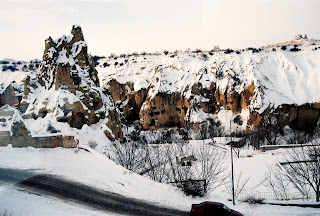
The inhabited landscape of Cappadocia and Goreme was characterized by red sandstones and salt deposits in early period, followed by the spewed out volcanic materials. Forces of eruptions and erosion plus wind shaped out the incredible unique turf-coned landscape. Rocks of Cappadocia eroded into hundreds of spectacular pillars and minaret-like forms.


Largely underlain by sedimentary rocks formed by lakes, streams and ignimbrite deposits erupted from ancient volcanoes about 9-13 million years ago.



There are more than 30 valleys of this kind in the region offering majestic view of beauty in the unique terrain


Goreme is a monastic center in between 300 to 1200 AD. Series of churches and chapels are rich with fresco designs.


The rock-carved churches and chapels.



Goreme Open Air Museum is the most visited and famous sites in central Turkey. Different kind of unique shapes formation are at all corners when strolling down the museum.



Unique geological, historic and cultural features is an incredible landscape. It is natural but also historical sites.



Labyrinth type of fortresses were dotted with strange shapes of chimneys, pigeonhole rock-hew houses and churches like The Elmah (Apple) Church.



Geological miracle Fortress with countless irregular shaped pillars, cones and chimneys.

Goreme town with rock houses is situated in front of valleys. Rock-cut houses and the fairy chimneys are the main attraction to millions of tourists from places all over the world.
Volcanic deposits are soft rocks that villagers at Cappadocia region carved out to form houses, churches, monasteries and small miniature souvenir for sales.


Volcanic deposits are soft rocks that villagers at Cappadocia region carved out to form houses, churches and monasteries. The look of pierced volcanic peaks under sunset is a piece of painting art.


Local women, girls and boys of the villages in their costumes. The little boy selling small miniature souvenir at the site attracted most visitors' attention..



We visited Kaymakli underground city which had 8 layers of floors with 1200 rooms, a connecting tunnel roads of 10 km and able to shelter 10 thousand of people. Miles of shops selling their handicrafts along the entrance staircase towards the underground city.


There are about 40 underground cities in the region but only 6 were opened for visit and the biggest is The Derinkuyu Underground City. Underground cities were the early settlement of local residents in the volcanic rocks in form of tufa to protect away from animals, invasion and hard winter conditions. Areas were gradually developed and enlarged cavities according to their need. Each cavity was connected with tunnels and labyrinths, locking stones which could only be opened and closed from inside to against outside threats. When making food, smoke were strictly prohibited to escape from inside, as could be seen from the black ceiling of the cooking area.



Underground Cities were one of the most important place in the spreading period of Christianity as the first Christian while escaped from persecution of Roman Empire in 2nd to 3rd century found the place to hide themselves for a long duration. They built ventilation chimneys, water wells, kitchen, toilets and provision rooms for churches, abbeys, meeting rooms etc.



A view of the little township where Kaymakli underground city located ..



The backyard of the hotel where we stayed had turned into a white world in this early winter.


Beautiful snow-capped houses of Goreme and Cappadocia town, viewed from our hotel-room window


Sample of typical Goreme house made from volcano tuff and the Goreme in its serene moment under freezing chilled air in severe winter season.


The beautiful hand made Avanos pottery and ceramic products of an underground factory. The red clay used are obtained from Kizilirmak River also known as Red River that run through the city. Silk carpets are produced from cottage factory and mainly hand-made by women. It takes 6-8 months to complete one medium size carpet. Technology of making pottery and breeding silkworm to extract silk to make elegant products were introduced from China.



No comments:
Post a Comment